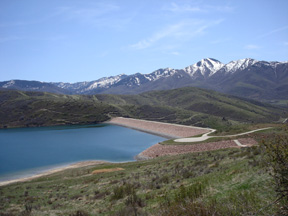Water Supply Outlook
Poor snowpack reduces stream flows, edging the state into moderate drought conditions; water conservation ethic urged.
LeRoy W. Hooton, Jr.
May 22, 2007
|
On May 1, the U.S. Weather Service (Colorado River Forecast Center) released its forecast for snowmelt run-off flows for the period of April thru July. The forecast reported flows below 50 percent of normal along the Wasatch Front. The stream forecast for the Utah Lake Basin, which includes the Provo River and Six Canyon Creeks in Salt Lake County is only 45 percent of normal. This gloomy forecast is attributed to a lower than normal winter snowpack, a dry April and above average temperatures. The report further stated that if these conditions continue during the summer months, the projected water supply outlook will be near record lows.
The following is a summary of the reports for the April – July stream flow forecast:
- Bear River Basin: 40 percent of normal
- Weber Basin: 45 percent of normal
- Utah Lake: 45 percent of normal
- Six Canyon Creeks
- City Creek: 41 percent of normal
- Emigration Creek: 20 percent of normal
- Parley’s Creek: 21 percent of normal
- Big Cottonwood: 55 percent of normal
- Little Cottonwood: 60 percent of normal
Current Reservoir Storage
Despite lower than normal run-off, reservoirs are nearly full, replenished from the above normal precipitation of the past two years.
- Jordanelle Reservoir: 83 percent full
- Deer Creek Reservoir: 97 percent full
- Utah Lake: 104 percent full
- Little Dell & Mt. Dell Reservoirs: 87 percent
- Colorado River Reservoirs: Flaming Gorge 85 percent; LakePowell 48 percent; and Strawberry Reservoir 85 percent
- Statewide: 72 percent full – the same percentage as a year ago at this time
|
Drought Monitor
The lack of normal precipitation has edged most of the State of Utah into moderate drought conditions, with severe drought conditions in Washington County, Utah. Extreme drought conditions are developing in southern California and southwest Arizona.
Water conservation success
- State-wide water usage in 2005 was 258 gpcd, a decrease of 30 percent from the high in 1990 of 367 gpcd, including secondary water use. All water suppliers along the Wasatch Front report decreased water use.
- Salt Lake City’s 2005 per capita use was 226 gpcd (using resident population). However nearly 45 percent of Salt Lake City’s water use is used by non-residents. Using net non-resident work force equivalent population, the number is 200 gpcd.
- Salt Lake City’s water usage was reduced by 17 percent from 2000 to 2005.
Water Restrictions?
Based on reservoir storage volumes, healthy ground water levels and existing conservation success, water suppliers along the Wasatch Front are not planning to impose more stringent water use measures or restrictions this coming year. However, if conditions worsen, this could change.
Despite lower than normal canyon stream flows, Salt Lake City will have an adequate water supply this summer. Key to this is the conservation effort of its customers over the past several years. Also, the large reservoirs in which Public Utilities depends upon are full. The Metropolitan Water District will receive a full allocation of 61,700 acre-feet in Deer Creek Reservoir; and 12,000 acre-feet of water from Jordanelle Reservoir. Little Dell and Mt. Dell Reservoirs will be nearly full. Utah Lake, which Public Utilities depends upon to meet its exchange agreements is also full.
Notwithstanding an adequate water supply, Public Utilities customers are urged to conserve water by continuing to practice its water conservation ethic.
Water supply forecasts are more direr in the southwester part of the state where conditions are much worse with a dismal 20 percent of normal snowpack. In Washington County, Utah public alerts have been issued.

